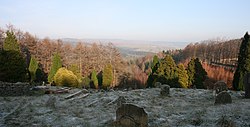Ynysybwl
| Ynysybwl | |
| Glamorgan | |
|---|---|
 Llanwynno Forest in winter, seen from St Gwynno's Church | |
| Location | |
| Grid reference: | ST054949 |
| Location: | 51°38’24"N, 3°22’3"W |
| Data | |
| Population: | 4,664 (2011[1]) |
| Post town: | Pontypridd |
| Dialling code: | 01443 |
| Local Government | |
| Council: | Rhondda Cynon Taf |
| Parliamentary constituency: |
Cynon Valley |
Ynysybwl is a village in the valley of the Nant Clydach in Glamorgan. It is situated in four miles north of Pontypridd and ten miles south of Merthyr Tydfil. The valley of the Clydach is flanked by the Rhondda and Cynon Valleys. The market town of Pontypridd lies to the south at the meeting point of the three valleys; and to the north lies the large Llanwynno forestry.
Name
There is debate over the meaning of the name of the village with several conflicting definitions existing.
Ynys mean island in Welsh but no official translation for bŵl exists. Some theories include mutation from pwll (Welsh for pool), a loan-word from English bowl[2] (a reference to the shape of the valley) or mutation from the name Hywel (a monk from Margam who is said to have worked the land in the 16th Century). Other locally considered meanings of bŵl include rock or coal but neither has any similarity to Welsh equivalent words.
Locally, the village is often referred to as just "Bwl" or "The Bwl".
Early History
Ynysybwl is located in the centre of the Llanwynno parish, at the point where the stream known as Y Ffrwd flows into the Clydach. Then a collection of small local farms and meadows in a quiet and completely rural valley, at the 1841 census around 200 people lived in the village and surrounding farms.[3]
Religion
As an industrial community developed a number of chapels were opened, including Bethel, the origins of which pre-dated the industrial era, and Jerusalem] (Calvinistic Methodist), Noddfa (Baptist) and Tabernacle (Independent).
Coal Industry
The rich seams of coal in the Mynachdy level that lie beneath the surface had thus far only been tapped to the amount required to supply these local farms. David Davies began test bores in the early 1880s at Graigddu ("Black Rock"), which proved positive, and the resultant sinking of Lady Windsor Colliery by the Ocean Coal Company on 16 June 1884 gave birth to new coal town.[3]
Lady Windsor Colliery
Lady Windsor Colliery opened in 1886, with 300 new miners' houses built on the opposite (western) side of the valley in typical terraced fashion by the mining company to house its workers and their families.
At its peak, the colliery employed around 1,500 people directly, although most of the 6,000-7,000 village community relied upon the pit in one way or another. The pit thrived throughout the first half of the 20th century, one of a number of very successful mines in South Wales.
However coal mining fell out of favour with many people, including politicians, and the Lady Windsor Colliery did not escape the troubles that plagued the industry during the miners' strikes of the early 1980s. The pit was finally closed in 1988.
Present day
Despite the pit closure, the village has survived, people finding work in the newly developing industries in nearby Pontypridd, Treforest, Aberdare, Caerphilly, Merthyr Tydfil and Cardiff.
This, coupled with the replacement of the pit as the village focus by local churches, Nonconformist chapels, clubs and associations, has led to a renewed interest in regeneration of the village. This led to the formation of the Ynysybwl Regeneration Partnership, an umbrella group formed to help achieve funding and organisation for activities within the village.
Today, Ynysybwl has many clubs and associations for such a small village, boasting cricket, football, rugby, karate, netball, bowls, a pony club, a brass band (Lady Windsor Colliery Band) and sections of the Brownies.
The nearby Llanwynno forestry also has the successful Cwm Clydach Outdoor Activity Group, an outdoor pursuits centre run by people from the village, and a newly developing cycle path that will form part of the local Taff Trail.
Transport
The Taff Vale Railway financed and operated the Ynysybwl railway, a branch line which left the main Taff Vale line. Initially the junction faced northwards;[4] later a chord was added to make a southwards connection at Clydach Court Junction.[5] The branch line opened a year after the Lady Windsor Colliery. The last passenger train from Ynysybwl Halt to Pontypridd was in 1953.[6]
Notable people
- Alun "Barrie" Davies - rugby, Welsh team coach
- Garin Jenkins - Wales' most-capped hooker
- Staff Jones - rugby, capped for Wales in 1983 and toured with the British Lions to New Zealand in 1985
- Dale McIntosh - rugby, Pontypridd RFC captain
- Clive Pritchard - rugby, Welsh team manager 1999
- Leighton Rees - darts player, first ever World Champion in 1978
- Tommy Scourfield - rugby union player capped for Wales in 1930
- Huw James - Colonel, British Army
References
- ↑ "Community population 2011". http://www.neighbourhood.statistics.gov.uk/dissemination/LeadKeyFigures.do?a=7&b=11131092&c=Ynyshir&d=16&e=62&g=6495254&i=1001x1003x1032x1004&m=0&r=1&s=1447772274752&enc=1. Retrieved 17 November 2015.
- ↑ http://www.someplacenamesinsouthwales.4t.com/rich_text_10.html Some Place Names in South Wales
- ↑ 3.0 3.1 http://webapps.rhondda-cynon-taff.gov.uk/heritagetrail/taff/ynysybwl/ynysybwl.htm
- ↑ Ordnance Survey County Series 1:10560 Glamorganshire 1st revn (1901) OS Grid ST09
- ↑ Ordnance Survey County Series 1:10560 Glamorganshire 2nd revn (1921) OS Grid ST09
- ↑ http://web.archive.org/web/20010210005749/http://www.rhodridavies.btinternet.co.uk/index3.htm